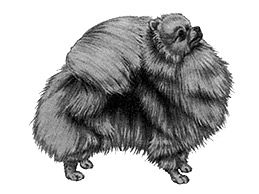Pomeranian Breed Standard
Last updated: 30 Oct 2014
A breed standard is the guideline which describes the ideal characteristics, temperament, and appearance of a breed and ensures that the breed is fit for function with soundness essential. Breeders and judges should at all times be mindful of features which could be detrimental in any way to the health, welfare or soundness of this breed.

-
Group:
Group 1 (Toys)
-
History:
-
General Appearance:
Compact, short coupled dog, well knit in frame. Exhibiting great intelligence in expression; activity and buoyancy in deportment.
-
Characteristics:
Sound, vivacious and dainty.
-
Temperament:
Extrovert, lively and intelligent.
-
Head And Skull:
Head and nose foxy in outline, skull slightly flat, large in proportion to muzzle which finishes finely and free from lippiness. Nose black in white, orange and shaded sable dogs; brown in chocolate tipped sable dogs, but in others colours may be 'self-coloured', never parti-coloured or flesh.
-
Eyes:
Medium size, slightly oval, not full, or set too wide apart; bright, dark and showing great intelligence. In white, orange, shaded sable and cream dogs, rims black.
-
Ears:
Relatively small, not set too wide apart, not too low down, but carried perfectly erect.
-
Mouth:
Jaws strong, with a perfect, regular and compete scissor bite, i.e. the upper teeth closely overlapping the lower teeth and set square to the jaws.
-
Neck:
Rather short and well set into shoulders.
-
Forequarters:
Shoulders clean and well laid back. Fine boned legs, perfectly straight, of medium length in due proportion to size of dog.
-
Body:
Back short, body compact, well ribbed up, barrel well rounded. Chest fairly deep, not too wide but in proportion to size of dog.
-
Hindquarters:
Fine boned, legs neither cow-hocked nor wide behind; medium angulation.
-
Feet:
Small, compact and cat-like.
-
Tail:
Characteristic of breed, high set, turned over back and carried flat and straight, profusely covered with long, harsh, spreading hair.
-
Gait/Movement:
Free moving, brisk and buoyant.
-
Coat:
Two coats, an under coat and an outer coat. Former soft, fluffy, the latter long, perfectly straight, harsh in texture and covering whole of body; very abundant round neck and fore part of shoulders and chest; forming frill, extending over shoulders. Forequarters well feathered, thighs and hindlegs well feathered to hocks.
-
Colour:
All whole colours permissible, but free from black or white shadings. Whole colours are: white, black, brown, light or dark, blue as pale as possible. Orange which should be self-coloured and bright as possible, Beaver. Cream dogs have black noses and black eye rims. Whites must be quite free from lemon or any other colour. A few white hairs in any of the self-coloured dogs permissible but undesirable. Dogs (other than white) with white or tan markings highly undesirable and not considered whole coloured specimens. In parti-coloured dogs, colours evenly distributed on body in patches; a dog with white or tan feet or chest not a parti-coloured dog. Shaded sables should be shaded throughout with three or more colours, the hair to be as uniformly shaded as possible, and with no patches of self-colour. In mixed classes, where whole coloured and parti-coloured Pomeranians compete together, the preference should, if in all other points they are equal, be given to the whole coloured specimens.
-
Sizes:
Ideal weight: Dogs 1.8-2 kg (4-4.5 lbs)
Bitches 2-2.5 kg (4.5-5.5 lbs)
-
Faults:
Any departure from the foregoing points should be considered a fault and the seriousness with which the fault should be regarded should be in exact proportion to its degree and its effect upon the health and welfare of the dog.
-
Notes:
Male animals should have two apparently normal testicles fully descended into the scrotum.
 For owners
For owners
 Members
Members
 Dogs Australia is a not-for-profit organisation advocating for the preservation of purebred dogs through ethical breeding.
It champions the highest standard of animal welfare through education and fostering dog-loving communities.
Internationally recognised and established in 1958 as the Australian National Kennel Council (ANKC),
the organisation promotes responsible dog ownership; maintains the ORCHID* heritable canine diseases database;
funds research into canine diseases; and supports state and territory-based member bodies.
Dogs Australia promotes breed conformation shows and community sports for dogs that fulfil a breed’s natural instincts.
Dogs Australia is a not-for-profit organisation advocating for the preservation of purebred dogs through ethical breeding.
It champions the highest standard of animal welfare through education and fostering dog-loving communities.
Internationally recognised and established in 1958 as the Australian National Kennel Council (ANKC),
the organisation promotes responsible dog ownership; maintains the ORCHID* heritable canine diseases database;
funds research into canine diseases; and supports state and territory-based member bodies.
Dogs Australia promotes breed conformation shows and community sports for dogs that fulfil a breed’s natural instincts.







